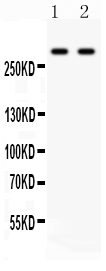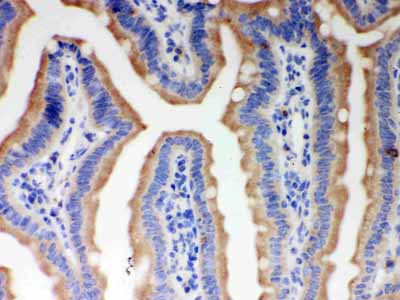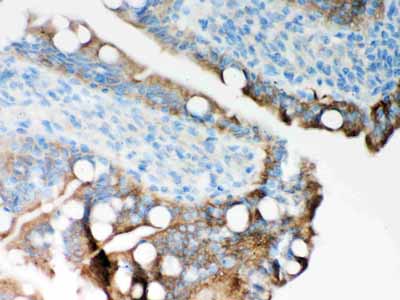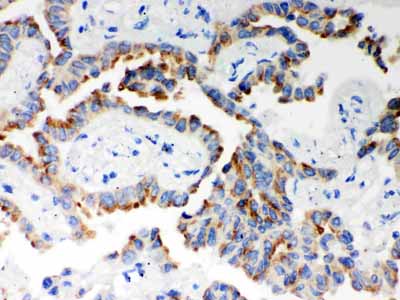Anti-ITPR3 Picoband Antibody
- SPECIFICATION
- CITATIONS
- PROTOCOLS
- BACKGROUND

Application
| WB, IHC-P |
|---|---|
| Primary Accession | Q14573 |
| Host | Rabbit |
| Reactivity | Human, Mouse, Rat |
| Clonality | Polyclonal |
| Format | Lyophilized |
| Description | Rabbit IgG polyclonal antibody for Inositol 1,4,5-trisphosphate receptor type 3(ITPR3) detection. Tested with WB, IHC-P in Human;Mouse;Rat. |
| Reconstitution | Add 0.2ml of distilled water will yield a concentration of 500ug/ml. |
| Gene ID | 3710 |
|---|---|
| Other Names | Inositol 1, 4, 5-trisphosphate receptor type 3, IP3 receptor isoform 3, IP3R 3, InsP3R3, Type 3 inositol 1, 4, 5-trisphosphate receptor, Type 3 InsP3 receptor, ITPR3 |
| Calculated MW | 304106 MW KDa |
| Application Details | Immunohistochemistry(Paraffin-embedded Section), 0.5-1 µg/ml, Human, Mouse, Rat, By Heat Western blot, 0.1-0.5 µg/ml, Human |
| Subcellular Localization | Endoplasmic reticulum membrane; Multi-pass membrane protein. |
| Tissue Specificity | Expressed in intestinal crypt and villus epithelial cells. |
| Protein Name | Inositol 1,4,5-trisphosphate receptor type 3 |
| Contents | Each vial contains 5mg BSA, 0.9mg NaCl, 0.2mg Na2HPO4, 0.05mg NaN3. |
| Immunogen | A synthetic peptide corresponding to a sequence at the N-terminus of human ITPR3 (70-95aa QYWKAKQTKQDKEKIADVVLLQKLQH), identical to the related mouse and rat sequences. |
| Purification | Immunogen affinity purified. |
| Cross Reactivity | No cross reactivity with other proteins |
| Storage | At -20˚C for one year. After r˚Constitution, at 4˚C for one month. It˚Can also be aliquotted and stored frozen at -20˚C for a longer time.Avoid repeated freezing and thawing. |
| Sequence Similarities | Belongs to the InsP3 receptor family. |
| Name | ITPR3 (HGNC:6182) |
|---|---|
| Function | Inositol 1,4,5-trisphosphate-gated calcium channel that, upon 1D-myo-inositol 1,4,5-trisphosphate binding, transports calcium from the endoplasmic reticulum lumen to cytoplasm, thus releasing the intracellular calcium and therefore participates in cellular calcium ion homeostasis (PubMed:32949214, PubMed:37898605, PubMed:8081734, PubMed:8288584). 1D-myo-inositol 1,4,5-trisphosphate binds to the ligand-free channel without altering its global conformation, yielding the low-energy resting state, then progresses through resting-to preactivated transitions to the higher energy preactivated state, which increases affinity for calcium, promoting binding of the low basal cytosolic calcium at the juxtamembrane domain (JD) site, favoring the transition through the ensemble of high-energy intermediate states along the trajectory to the fully-open activated state (PubMed:30013099, PubMed:35301323, PubMed:37898605). Upon opening, releases calcium in the cytosol where it can bind to the low-affinity cytoplasmic domain (CD) site and stabilizes the inhibited state to terminate calcium release (PubMed:30013099, PubMed:35301323, PubMed:37898605). |
| Cellular Location | Endoplasmic reticulum membrane {ECO:0000250|UniProtKB:Q63269}; Multi-pass membrane protein. Cytoplasmic vesicle, secretory vesicle membrane {ECO:0000250|UniProtKB:Q8WN95}; Multi-pass membrane protein. Note=Also localizes at mitochondria-associated membranes (MAMs). {ECO:0000250|UniProtKB:P70227} |
| Tissue Location | Expressed in intestinal crypt and villus epithelial cells. |

Thousands of laboratories across the world have published research that depended on the performance of antibodies from Abcepta to advance their research. Check out links to articles that cite our products in major peer-reviewed journals, organized by research category.
info@abcepta.com, and receive a free "I Love Antibodies" mug.
Provided below are standard protocols that you may find useful for product applications.
Background
ITPR3 encodes a receptor for inositol 1,4,5-trisphosphate, a second messenger that mediates the release of intracellular calcium. The receptor contains a calcium channel at the C-terminus and the ligand-binding site at the N-terminus. Knockout studies in mice suggest that type 2 and type 3 inositol 1,4,5-trisphosphate receptors play a key role in exocrine secretion underlying energy metabolism and growth. ITP3 channels serve an important role in the taste transduction pathway of sweet, bitter and umami tastes the gustatory system. ITP3 channels allow the flow of Calcium out of the endoplasmic reticulum in response to IP3. Calcium cations result in the activation of TRPM5 which leads to a depolarisation generating potential and an action potential.
If you have used an Abcepta product and would like to share how it has performed, please click on the "Submit Review" button and provide the requested information. Our staff will examine and post your review and contact you if needed.
If you have any additional inquiries please email technical services at tech@abcepta.com.













 Foundational characteristics of cancer include proliferation, angiogenesis, migration, evasion of apoptosis, and cellular immortality. Find key markers for these cellular processes and antibodies to detect them.
Foundational characteristics of cancer include proliferation, angiogenesis, migration, evasion of apoptosis, and cellular immortality. Find key markers for these cellular processes and antibodies to detect them. The SUMOplot™ Analysis Program predicts and scores sumoylation sites in your protein. SUMOylation is a post-translational modification involved in various cellular processes, such as nuclear-cytosolic transport, transcriptional regulation, apoptosis, protein stability, response to stress, and progression through the cell cycle.
The SUMOplot™ Analysis Program predicts and scores sumoylation sites in your protein. SUMOylation is a post-translational modification involved in various cellular processes, such as nuclear-cytosolic transport, transcriptional regulation, apoptosis, protein stability, response to stress, and progression through the cell cycle. The Autophagy Receptor Motif Plotter predicts and scores autophagy receptor binding sites in your protein. Identifying proteins connected to this pathway is critical to understanding the role of autophagy in physiological as well as pathological processes such as development, differentiation, neurodegenerative diseases, stress, infection, and cancer.
The Autophagy Receptor Motif Plotter predicts and scores autophagy receptor binding sites in your protein. Identifying proteins connected to this pathway is critical to understanding the role of autophagy in physiological as well as pathological processes such as development, differentiation, neurodegenerative diseases, stress, infection, and cancer.





